technical specifications FIAT DUCATO 2010 Owner handbook (in English)
[x] Cancel search | Manufacturer: FIAT, Model Year: 2010, Model line: DUCATO, Model: FIAT DUCATO 2010Pages: 286, PDF Size: 12.53 MB
Page 134 of 286
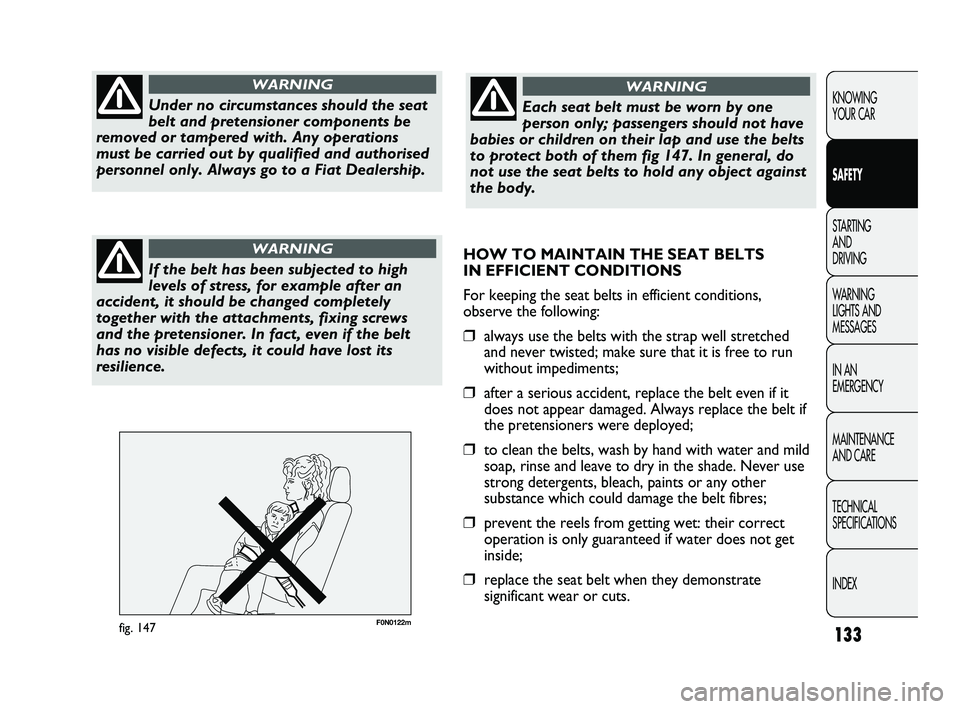
133
KNOWING
YOUR CAR
SAFETY
STARTING
AND
DRIVING
WARNING
LIGHTS AND
MESSAGES
IN AN
EMERGENCY
MAINTENANCE
AND CARE
TECHNICAL
SPECIFICATIONS
INDEX
F0N0122mfig. 147
Under no circumstances should the seat
belt and pretensioner components be
removed or tampered with. Any operations
must be carried out by qualified and authorised
personnel only. Always go to a Fiat Dealership.
WARNING
If the belt has been subjected to high
levels of stress, for example after an
accident, it should be changed completely
together with the attachments, fixing screws
and the pretensioner. In fact, even if the belt
has no visible defects, it could have lost its
resilience.
WARNING
Each seat belt must be worn by one
person only; passengers should not have
babies or children on their lap and use the belts
to protect both of them fig 147. In general, do
not use the seat belts to hold any object against
the body.
WARNING
HOW TO MAINTAIN THE SEAT BELTS
IN EFFICIENT CONDITIONS
For keeping the seat belts in efficient conditions,
observe the following:
❒always use the belts with the strap well stretched
and never twisted; make sure that it is free to run
without impediments;
❒after a serious accident, replace the belt even if it
does not appear damaged. Always replace the belt if
the pretensioners were deployed;
❒to clean the belts, wash by hand with water and mild
soap, rinse and leave to dry in the shade. Never use
strong detergents, bleach, paints or any other
substance which could damage the belt fibres;
❒prevent the reels from getting wet: their correct
operation is only guaranteed if water does not get
inside;
❒replace the seat belt when they demonstrate
significant wear or cuts.
129-146 DUCATO LUM EN 7ed 6/21/10 2:12 PM Page 133
Page 135 of 286
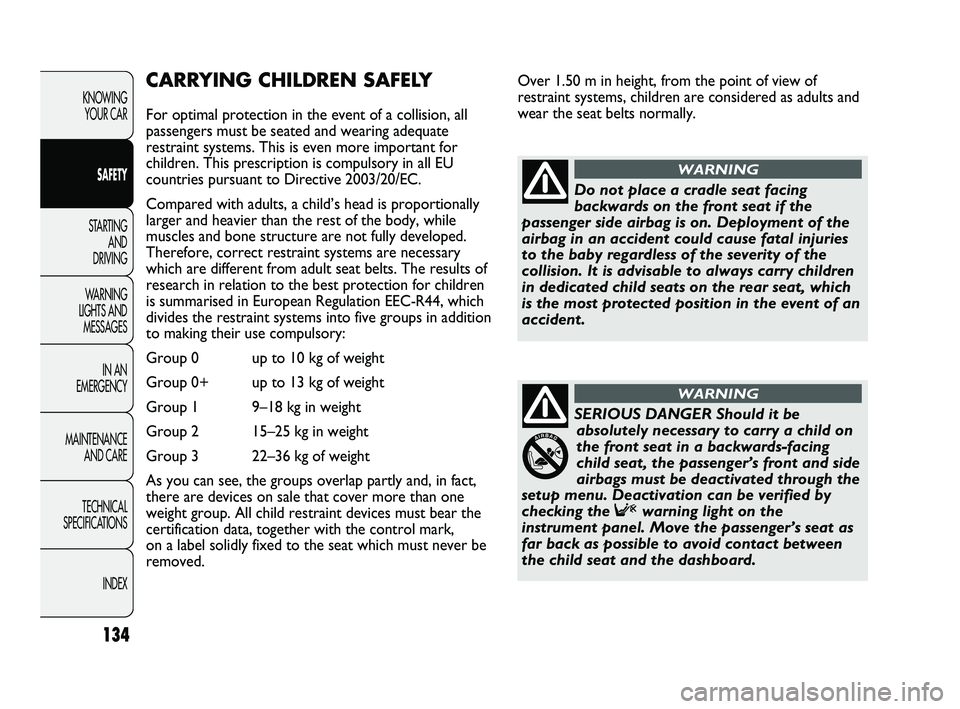
Over 1.50 m in height, from the point of view of
restraint systems, children are considered as adults and
wear the seat belts normally.
134
KNOWING
YOUR CAR
SAFETY
STARTING
AND
DRIVING
WARNING
LIGHTS AND
MESSAGES
IN AN
EMERGENCY
MAINTENANCE
AND CARE
TECHNICAL
SPECIFICATIONS
INDEX
CARRYING CHILDREN SAFELY
For optimal protection in the event of a collision, all
passengers must be seated and wearing adequate
restraint systems. This is even more important for
children. This prescription is compulsory in all EU
countries pursuant to Directive 2003/20/EC.
Compared with adults, a child’s head is proportionally
larger and heavier than the rest of the body, while
muscles and bone structure are not fully developed.
Therefore, correct restraint systems are necessary
which are different from adult seat belts. The results of
research in relation to the best protection for children
is summarised in European Regulation EEC-R44, which
divides the restraint systems into five groups in addition
to making their use compulsory:
Group 0 up to 10 kg of weight
Group 0+ up to 13 kg of weight
Group 1 9–18 kg in weight
Group 2 15–25 kg in weight
Group 3 22–36 kg of weight
As you can see, the groups overlap partly and, in fact,
there are devices on sale that cover more than one
weight group. All child restraint devices must bear the
certification data, together with the control mark,
on a label solidly fixed to the seat which must never be
removed.
Do not place a cradle seat facing
backwards on the front seat if the
passenger side airbag is on. Deployment of the
airbag in an accident could cause fatal injuries
to the baby regardless of the severity of the
collision. It is advisable to always carry children
in dedicated child seats on the rear seat, which
is the most protected position in the event of an
accident.
WARNING
SERIOUS DANGER Should it be
absolutely necessary to carry a child on
the front seat in a backwards-facing
child seat, the passenger’s front and side
airbags must be deactivated through the
setup menu. Deactivation can be verified by
checking the Fwarning light on the
instrument panel. Move the passenger’s seat as
far back as possible to avoid contact between
the child seat and the dashboard.
WARNING
129-146 DUCATO LUM EN 7ed 6/21/10 2:12 PM Page 134
Page 136 of 286
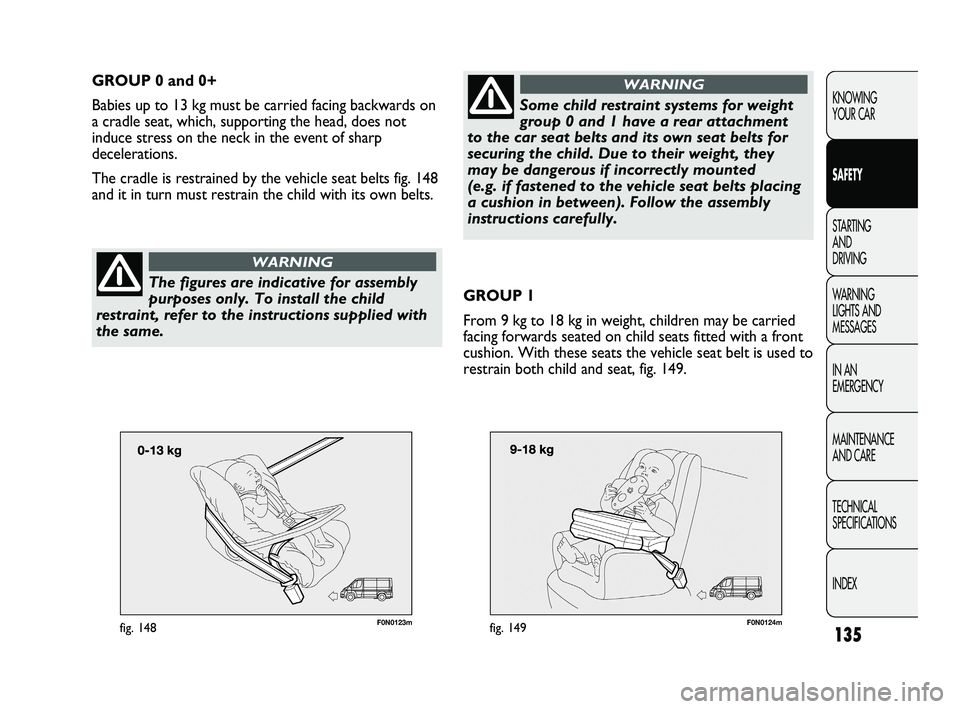
135
KNOWING
YOUR CAR
SAFETY
STARTING
AND
DRIVING
WARNING
LIGHTS AND
MESSAGES
IN AN
EMERGENCY
MAINTENANCE
AND CARE
TECHNICAL
SPECIFICATIONS
INDEX
F0N0123mfig. 148
GROUP 0 and 0+
Babies up to 13 kg must be carried facing backwards on
a cradle seat, which, supporting the head, does not
induce stress on the neck in the event of sharp
decelerations.
The cradle is restrained by the vehicle seat belts fig. 148
and it in turn must restrain the child with its own belts.
The figures are indicative for assembly
purposes only. To install the child
restraint, refer to the instructions supplied with
the same.
WARNING
F0N0124mfig. 149
GROUP 1
From 9 kg to 18 kg in weight, children may be carried
facing forwards seated on child seats fitted with a front
cushion. With these seats the vehicle seat belt is used to
restrain both child and seat, fig. 149.
Some child restraint systems for weight
group 0 and 1 have a rear attachment
to the car seat belts and its own seat belts for
securing the child. Due to their weight, they
may be dangerous if incorrectly mounted
(e.g. if fastened to the vehicle seat belts placing
a cushion in between). Follow the assembly
instructions carefully.
WARNING
129-146 DUCATO LUM EN 7ed 6/21/10 2:12 PM Page 135
Page 137 of 286
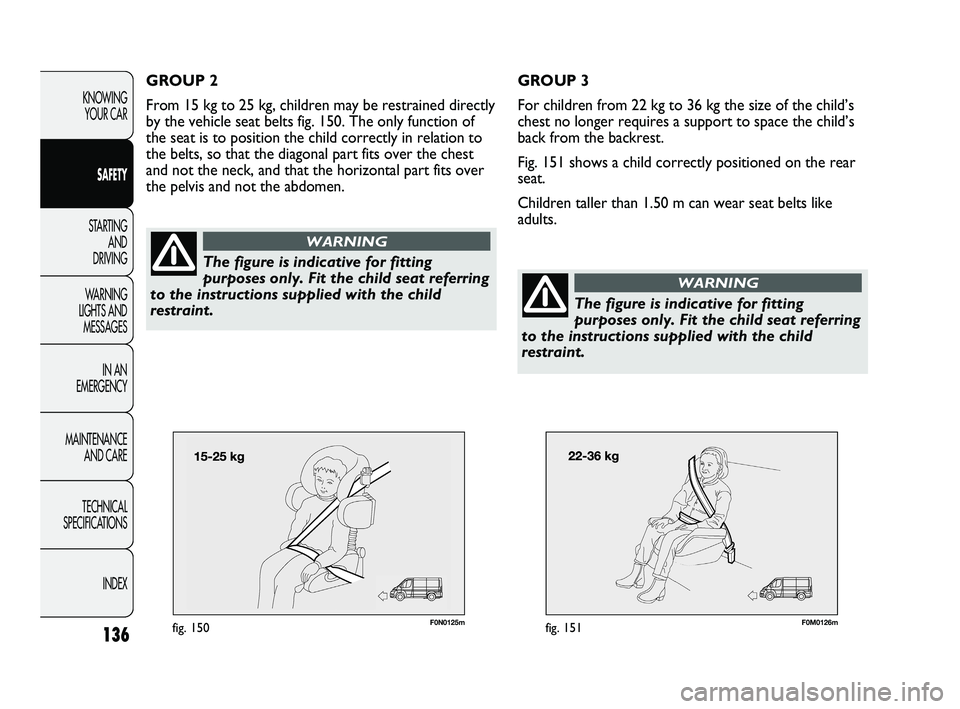
136
KNOWING
YOUR CAR
SAFETY
STARTING
AND
DRIVING
WARNING
LIGHTS AND
MESSAGES
IN AN
EMERGENCY
MAINTENANCE
AND CARE
TECHNICAL
SPECIFICATIONS
INDEX
F0N0125mfig. 150F0M0126mfig. 151
GROUP 3
For children from 22 kg to 36 kg the size of the child’s
chest no longer requires a support to space the child’s
back from the backrest.
Fig. 151 shows a child correctly positioned on the rear
seat.
Children taller than 1.50 m can wear seat belts like
adults. GROUP 2
From 15 kg to 25 kg, children may be restrained directly
by the vehicle seat belts fig. 150. The only function of
the seat is to position the child correctly in relation to
the belts, so that the diagonal part fits over the chest
and not the neck, and that the horizontal part fits over
the pelvis and not the abdomen.
The figure is indicative for fitting
purposes only. Fit the child seat referring
to the instructions supplied with the child
restraint.
WARNING
The figure is indicative for fitting
purposes only. Fit the child seat referring
to the instructions supplied with the child
restraint.
WARNING
129-146 DUCATO LUM EN 7ed 6/21/10 2:12 PM Page 136
Page 138 of 286
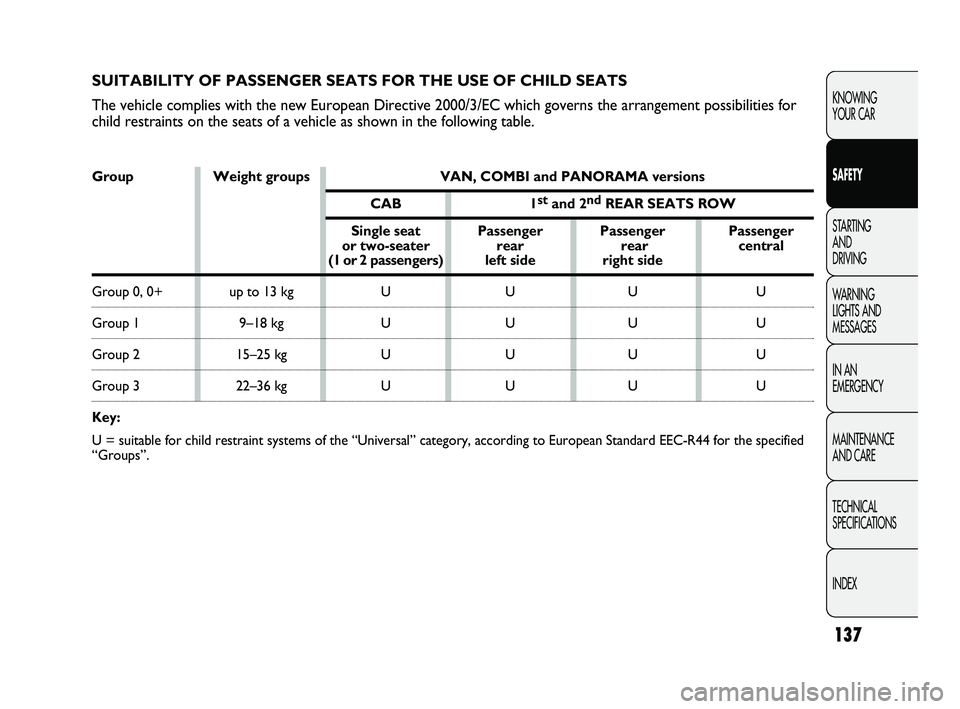
137
KNOWING
YOUR CAR
SAFETY
STARTING
AND
DRIVING
WARNING
LIGHTS AND
MESSAGES
IN AN
EMERGENCY
MAINTENANCE
AND CARE
TECHNICAL
SPECIFICATIONS
INDEX
SUITABILITY OF PASSENGER SEATS FOR THE USE OF CHILD SEATS
The vehicle complies with the new European Directive 2000/3/EC which governs the arrangement possibilities for
child restraints on the seats of a vehicle as shown in the following table.
Group Weight groups VAN, COMBI and PANORAMA versions
CAB 1stand 2ndREAR SEATS ROW
Single seat Passenger Passenger Passenger
or two-seater rear rear central
(1 or 2 passengers) left side right side
Group 0, 0+ up to 13 kg U U U U
Group 1 9–18 kg U U U U
Group 2 15–25 kg U U U U
Group 3 22–36 kg U U U U
Key:
U = suitable for child restraint systems of the “Universal” category, according to European Standard EEC-R44 for the specified
“Groups”.
129-146 DUCATO LUM EN 7ed 6/21/10 2:12 PM Page 137
Page 139 of 286
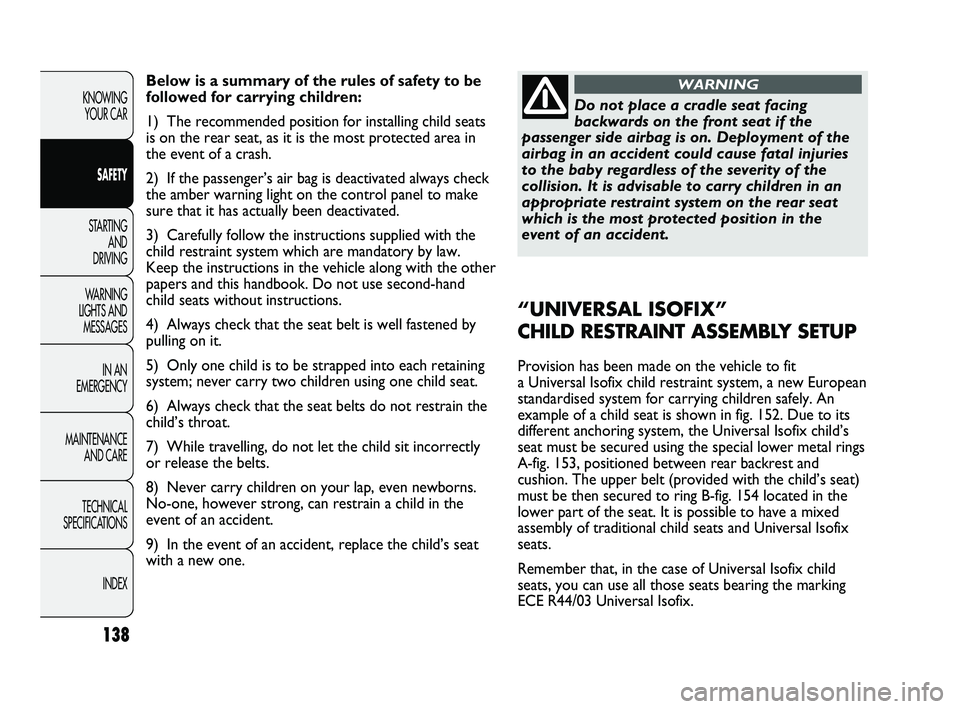
138
KNOWING
YOUR CAR
SAFETY
STARTING
AND
DRIVING
WARNING
LIGHTS AND
MESSAGES
IN AN
EMERGENCY
MAINTENANCE
AND CARE
TECHNICAL
SPECIFICATIONS
INDEX
Below is a summary of the rules of safety to be
followed for carrying children:
1) The recommended position for installing child seats
is on the rear seat, as it is the most protected area in
the event of a crash.
2) If the passenger’s air bag is deactivated always check
the amber warning light on the control panel to make
sure that it has actually been deactivated.
3) Carefully follow the instructions supplied with the
child restraint system which are mandatory by law.
Keep the instructions in the vehicle along with the other
papers and this handbook. Do not use second-hand
child seats without instructions.
4) Always check that the seat belt is well fastened by
pulling on it.
5) Only one child is to be strapped into each retaining
system; never carry two children using one child seat.
6) Always check that the seat belts do not restrain the
child’s throat.
7) While travelling, do not let the child sit incorrectly
or release the belts.
8) Never carry children on your lap, even newborns.
No-one, however strong, can restrain a child in the
event of an accident.
9) In the event of an accident, replace the child’s seat
with a new one.
Do not place a cradle seat facing
backwards on the front seat if the
passenger side airbag is on. Deployment of the
airbag in an accident could cause fatal injuries
to the baby regardless of the severity of the
collision. It is advisable to carry children in an
appropriate restraint system on the rear seat
which is the most protected position in the
event of an accident.
WARNING
“UNIVERSAL ISOFIX”
CHILD RESTRAINT ASSEMBLY SETUP
Provision has been made on the vehicle to fit
a Universal Isofix child restraint system, a new European
standardised system for carrying children safely. An
example of a child seat is shown in fig. 152. Due to its
different anchoring system, the Universal Isofix child’s
seat must be secured using the special lower metal rings
A-fig. 153, positioned between rear backrest and
cushion. The upper belt (provided with the child’s seat)
must be then secured to ring B-fig. 154 located in the
lower part of the seat. It is possible to have a mixed
assembly of traditional child seats and Universal Isofix
seats.
Remember that, in the case of Universal Isofix child
seats, you can use all those seats bearing the marking
ECE R44/03 Universal Isofix.
129-146 DUCATO LUM EN 7ed 6/21/10 2:12 PM Page 138
Page 140 of 286
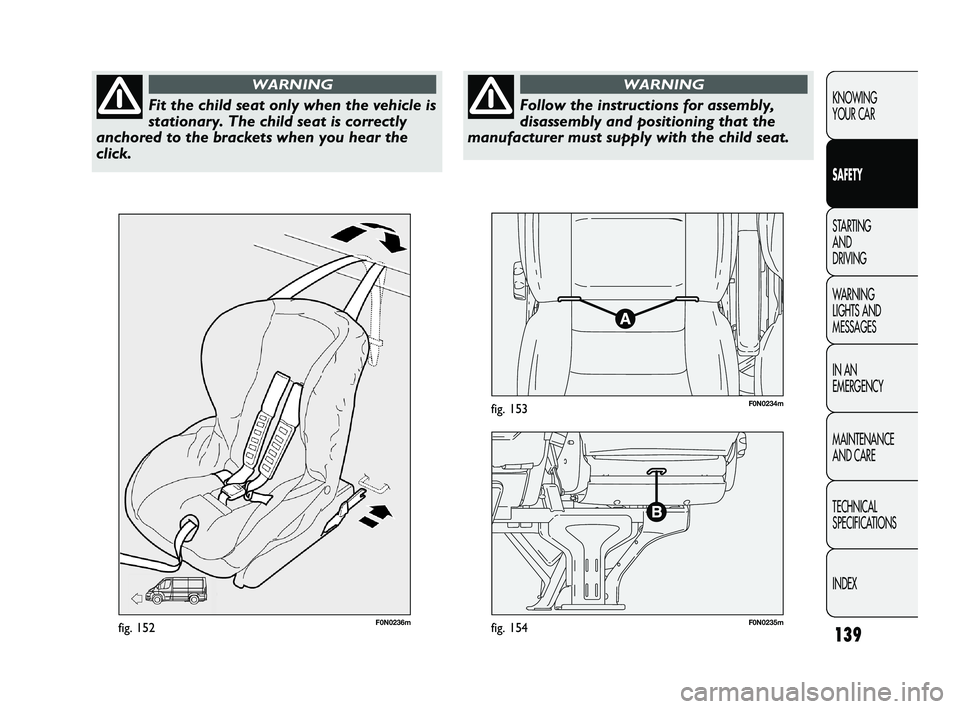
139
KNOWING
YOUR CAR
SAFETY
STARTING
AND
DRIVING
WARNING
LIGHTS AND
MESSAGES
IN AN
EMERGENCY
MAINTENANCE
AND CARE
TECHNICAL
SPECIFICATIONS
INDEX
F0N0236mfig. 152F0N0235mfig. 154
F0N0234mfig. 153
Fit the child seat only when the vehicle is
stationary. The child seat is correctly
anchored to the brackets when you hear the
click.
WARNING
Follow the instructions for assembly,
disassembly and positioning that the
manufacturer must supply with the child seat.
WARNING
129-146 DUCATO LUM EN 7ed 6/21/10 2:12 PM Page 139
Page 141 of 286
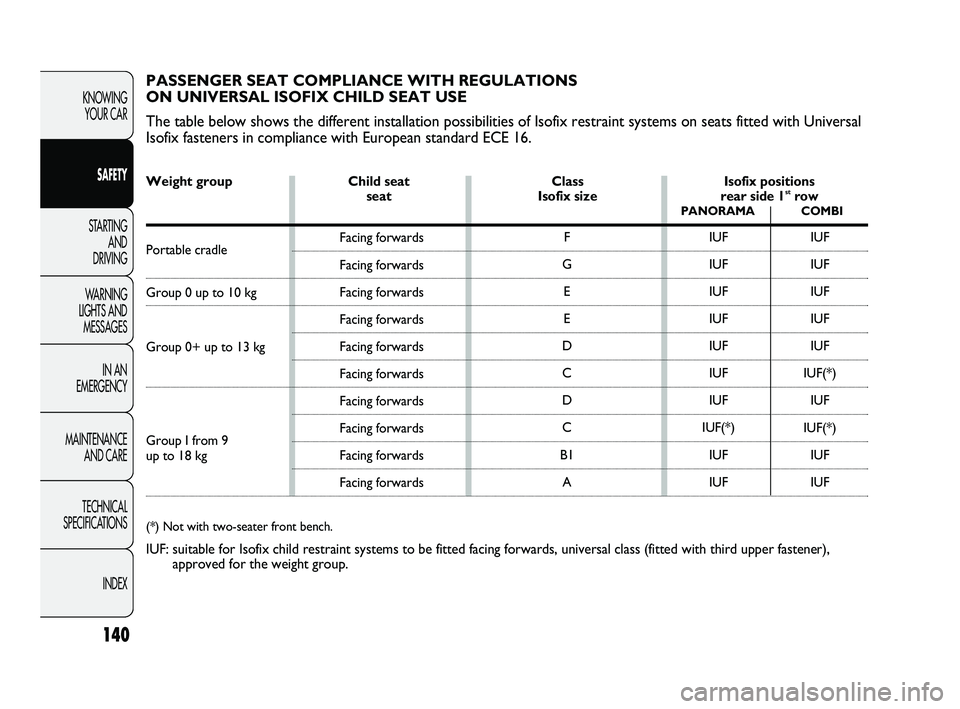
140
KNOWING
YOUR CAR
SAFETY
STARTING
AND
DRIVING
WARNING
LIGHTS AND
MESSAGES
IN AN
EMERGENCY
MAINTENANCE
AND CARE
TECHNICAL
SPECIFICATIONS
INDEX
PASSENGER SEAT COMPLIANCE WITH REGULATIONS
ON UNIVERSAL ISOFIX CHILD SEAT USE
The table below shows the different installation possibilities of Isofix restraint systems on seats fitted with Universal
Isofix fasteners in compliance with European standard ECE 16.
Weight group Child seat Class Isofix positions
seat Isofix size rear side 1strowPANORAMA COMBI
Portable cradle
Group 0 up to 10 kg
Group 0+ up to 13 kg
Group I from 9
up to 18 kg
Facing forwards
Facing forwards
Facing forwards
Facing forwards
Facing forwards
Facing forwards
Facing forwards
Facing forwards
Facing forwards
Facing forwardsF
G
E
E
D
C
D
C
B1
AIUF
IUF
IUF
IUF
IUF
IUF
IUF
IUF(*)
IUF
IUFIUF
IUF
IUF
IUF
IUF
IUF(*)
IUF
IUF(*)
IUF
IUF
(*) Not with two-seater front bench.
IUF: suitable for Isofix child restraint systems to be fitted facing forwards, universal class (fitted with third upper fastener),
approved for the weight group.
129-146 DUCATO LUM EN 7ed 6/21/10 2:12 PM Page 140
Page 142 of 286
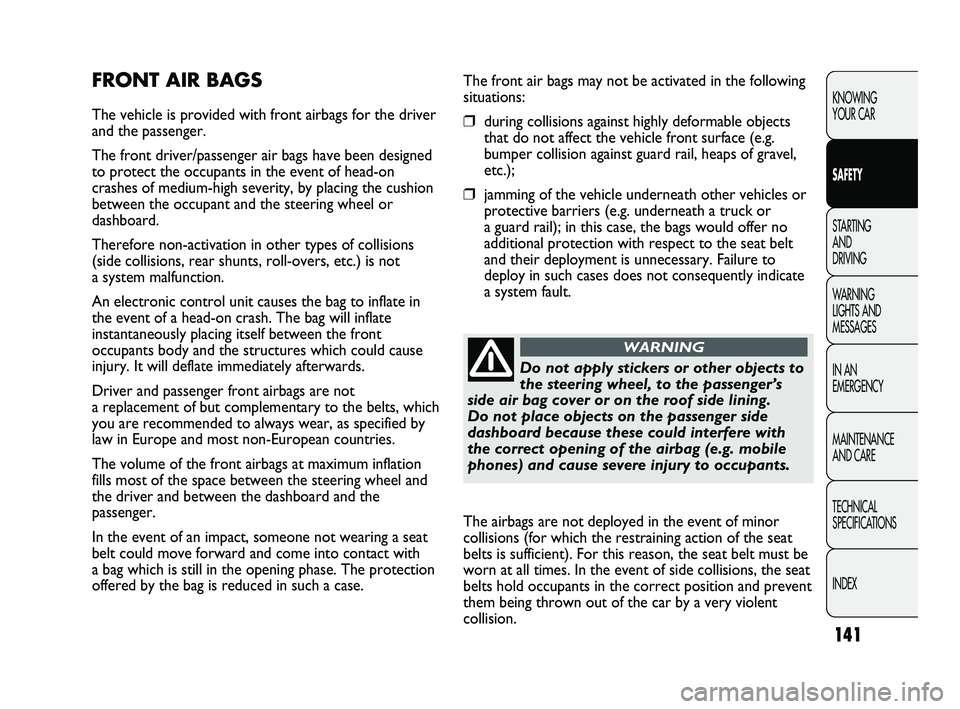
141
KNOWING
YOUR CAR
SAFETY
STARTING
AND
DRIVING
WARNING
LIGHTS AND
MESSAGES
IN AN
EMERGENCY
MAINTENANCE
AND CARE
TECHNICAL
SPECIFICATIONS
INDEX
The front air bags may not be activated in the following
situations:
❒during collisions against highly deformable objects
that do not affect the vehicle front surface (e.g.
bumper collision against guard rail, heaps of gravel,
etc.);
❒jamming of the vehicle underneath other vehicles or
protective barriers (e.g. underneath a truck or
a guard rail); in this case, the bags would offer no
additional protection with respect to the seat belt
and their deployment is unnecessary. Failure to
deploy in such cases does not consequently indicate
a system fault.
FRONT AIR BAGS
The vehicle is provided with front airbags for the driver
and the passenger.
The front driver/passenger air bags have been designed
to protect the occupants in the event of head-on
crashes of medium-high severity, by placing the cushion
between the occupant and the steering wheel or
dashboard.
Therefore non-activation in other types of collisions
(side collisions, rear shunts, roll-overs, etc.) is not
a system malfunction.
An electronic control unit causes the bag to inflate in
the event of a head-on crash. The bag will inflate
instantaneously placing itself between the front
occupants body and the structures which could cause
injury. It will deflate immediately afterwards.
Driver and passenger front airbags are not
a replacement of but complementary to the belts, which
you are recommended to always wear, as specified by
law in Europe and most non-European countries.
The volume of the front airbags at maximum inflation
fills most of the space between the steering wheel and
the driver and between the dashboard and the
passenger.
In the event of an impact, someone not wearing a seat
belt could move forward and come into contact with
a bag which is still in the opening phase. The protection
offered by the bag is reduced in such a case.
Do not apply stickers or other objects to
the steering wheel, to the passenger’s
side air bag cover or on the roof side lining.
Do not place objects on the passenger side
dashboard because these could interfere with
the correct opening of the airbag (e.g. mobile
phones) and cause severe injury to occupants.
WARNING
The airbags are not deployed in the event of minor
collisions (for which the restraining action of the seat
belts is sufficient). For this reason, the seat belt must be
worn at all times. In the event of side collisions, the seat
belts hold occupants in the correct position and prevent
them being thrown out of the car by a very violent
collision.
129-146 DUCATO LUM EN 7ed 6/21/10 2:12 PM Page 141
Page 143 of 286
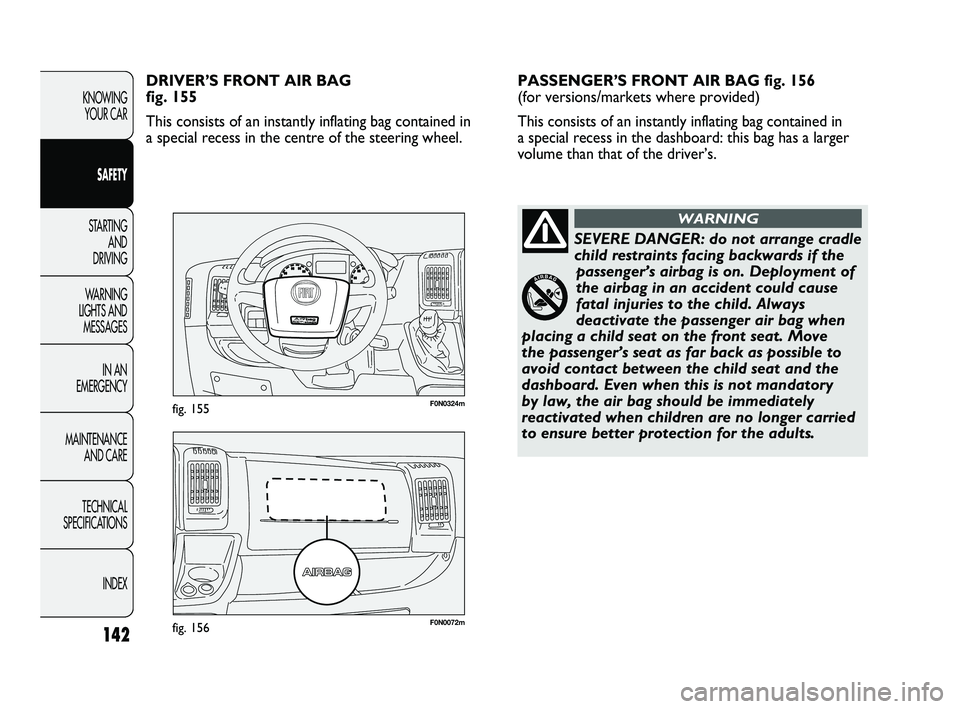
142
KNOWING
YOUR CAR
SAFETY
STARTING
AND
DRIVING
WARNING
LIGHTS AND
MESSAGES
IN AN
EMERGENCY
MAINTENANCE
AND CARE
TECHNICAL
SPECIFICATIONS
INDEX
F0N0072mfig. 156
F0N0324mfig. 155
PASSENGER’S FRONT AIR BAG fig. 156
(for versions/markets where provided)
This consists of an instantly inflating bag contained in
a special recess in the dashboard: this bag has a larger
volume than that of the driver’s. DRIVER’S FRONT AIR BAG
fig. 155
This consists of an instantly inflating bag contained in
a special recess in the centre of the steering wheel.
SEVERE DANGER: do not arrange cradle
child restraints facing backwards if the
passenger’s airbag is on. Deployment of
the airbag in an accident could cause
fatal injuries to the child. Always
deactivate the passenger air bag when
placing a child seat on the front seat. Move
the passenger’s seat as far back as possible to
avoid contact between the child seat and the
dashboard. Even when this is not mandatory
by law, the air bag should be immediately
reactivated when children are no longer carried
to ensure better protection for the adults.
WARNING
129-146 DUCATO LUM EN 7ed 6/21/10 2:12 PM Page 142